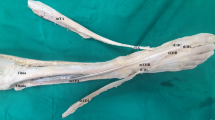Abstract
During routine dissection of an adult human cadaver, a suite of tendinous anomalies was discovered in the left hallucal region. Whereas the main tendon of the extensor hallucis longus muscle inserted normally, two accessory tendons were found coursing medial and lateral to the main tendon. The most lateral tendon originated from a supernumerary muscle belly and merged with the tendon of extensor hallucis brevis to form a composite tendon. The most medial tendon crossed the metatarsophalangeal joint and joined the composite tendon deep to the tendon of extensor hallucis longus. A terminal tendon, consisting of these three contributions, inserted upon the proximal hallucal phalanx. This variant likely arose due to atypical differentiation of the common extensor muscle mass during development, and is of particular significance to clinicians performing arthroscopy, tendon transfers, and other surgical procedures.
Similar content being viewed by others
References
Agur AMR, Dalley AF (2005) Grant’s Atlas of Anatomy, 11th edn. Lippincott Williams and Wilkins, Philadelphia.
Allum RL, Higginson DW (1983) Keller’s operation with basal osteotomy of first metatarsal. J R Soc Med 76, 116–20.
Al-saggaf S (2003) Variations in the insertion of the extensor hallucis longus muscle. Folia Morphol 62, 147–55.
Bibbo C, Arangio G, Patel DV (2004) The accessory tendon of the first metatarsophalangeal joint. Foot Ankle Int 25, 387–90.
Buckingham RA, Winson IG, Kelly AJ (1997) An anatomical study of a new portal for ankle arthroscopy. J Bone Joint Surg 79B, 650–52.
Christ B, Brand-Saberi B (2002) Limb muscle development. Int J Dev Biol 46, 905–14.
Denk CC, Öznur A, Sürücü HS (2002) Double tendons at the distal attachment of the extensor hallucis longus muscle. Surg Radiol Anat 24, 50–52.
Gray H (1918) Anatomy of the Human Body. Lea & Febiger, Philadelphia.
Griffiths JC (1965) Tendon injuries around the ankle. J Bone Joint Surg 47B, 686–9.
Ikiz ZAA, Üçerler H (2005) A previously unreported variation related to the insertion of the tibialis anterior muscle and the superficial fibular (peroneal) nerve. Anat Sci Int 80, 172–5.
Johnson KA, Spiegl PV (1984) Extensor hallucis longus transfer for hallux varus deformity. J Bone Joint Surg 66A, 681–6.
Kaneff A, Andreev D (1983) Über die organogenetische Entwicklung des M. extensor hallucis longus beim Menschen. Anat Anz 154, 237–44.
Kaneff A, Stephanoff A (1982) Vergleichend-anatomische Untersuchung des M. extensor hallucis longus beim Menschen. Gegenbaurs Morphol Jahrb 128, 690–701.
Kimura K, Takahashi Y, Konishi M, Iwamoto S (1988) The extensor and peroneal muscles of the crab-eating monkey (Macaca fascicularis). Primates 29, 511–23.
Langdon JH (1990) Variations in cruropedal musculature. Int J Primatol 11, 575–606.
Larsen WJ (1997) human Embryology, 2nd edn. Churchill Livingstone, New York.
Lundeen RO, Latva D, Yant J (1983) The secondary tendinous slip of the extensor hallucis longus (extensor ossis metatarsi hallucis). J Foot Surg 22, 142–4.
Macalister A (1875) Additional observations on muscular anomalies in human anatomy. Trans R Ir Acad Sci 25, 1–130.
Moore KL, Dalley AF (2005) Clinically Oriented Anatomy, 5th edn. Lippincott Williams and Wilkins, Philadelphia.
Moore KL, Persaud TVN (1998) Before We Are Born: Essentials of Embryology and Birth Defects, 5th edn. WB Saunders, Philadelphia.
Rosse C, Gaddum-Rosse P (1997) Hollinshead’s Textbook of Anatomy, 5th edn. Lippincott-Raven, Philadelphia.
Sakuma E, Kato H, Honda N, Mabuchi Y, Soji T (2004) A rare anomaly of the extensor digitorum longus. Anat Sci Int 79, 235–8.
Sgarlato DE, Sokoloff TH, Mosher M (1969) Anomalous insertion of extensor hallucis longus tendon: A case report. J Am Podiatry Assoc 59, 192–3.
Tate R, Pachnik RL (1976) The accessory tendon of extensor hallucis longus: Its occurrence and function. J Am Podiatry Assoc 66, 899–907.
Author information
Authors and Affiliations
Corresponding author
Rights and permissions
About this article
Cite this article
Hill, R.V., Gerges, L. Unusual accessory tendon connecting the hallucal extensors. Anato Sci Int 83, 298–300 (2008). https://doi.org/10.1111/j.1447-073X.2008.00229.x
Received:
Accepted:
Issue Date:
DOI: https://doi.org/10.1111/j.1447-073X.2008.00229.x




